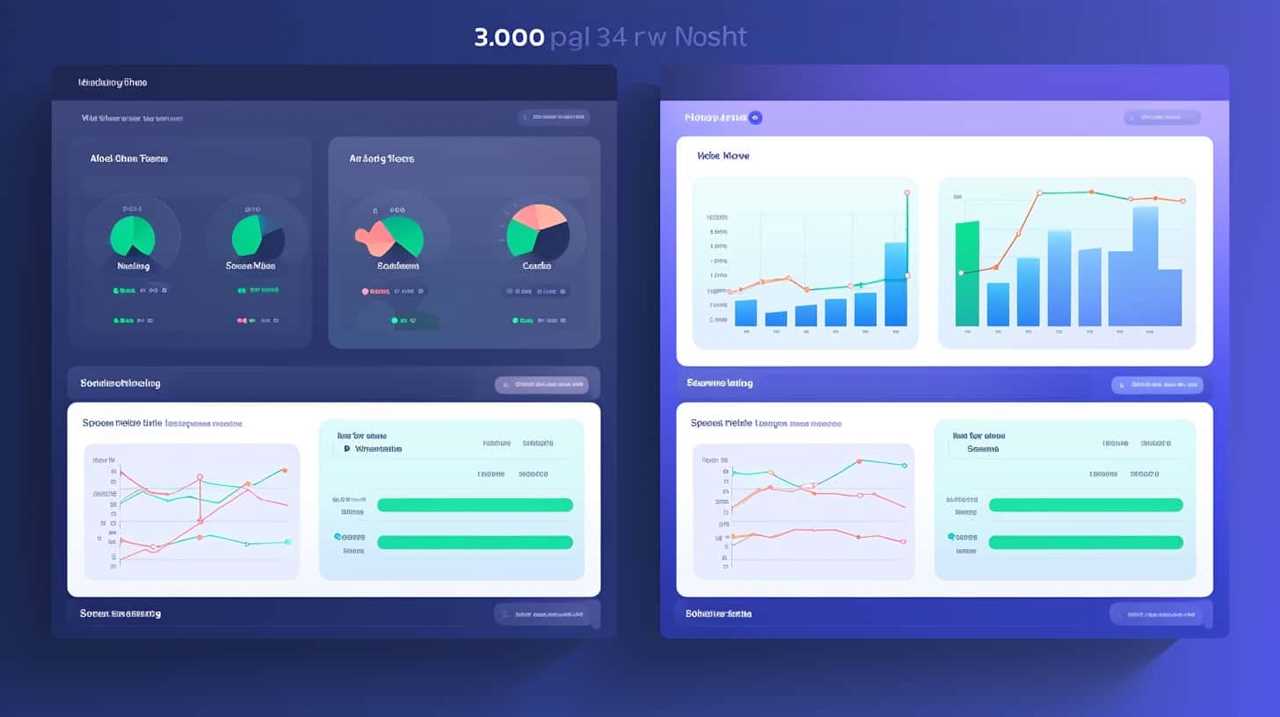Ladies and gentlemen, imagine this scenario: a delightful, neighborhood dining spot finding it challenging to draw in patrons amidst a busy online world.
But fear not, for we have discovered the secret recipe for success – Google Ads.
With a dash of online presence, a sprinkle of targeted ads, and a generous serving of mobile advertising, local eateries can thrive in the digital world.
So join us on this journey as we explore the power of Google Ads and how it can transform local eateries into digital sensations.

Key Takeaways
- A strong online presence and Google Ads are crucial for local eateries to thrive in the digital age.
- Targeting strategies such as demographic targeting, remarketing, and location targeting can help reach specific customer segments effectively.
- Optimizing Google Ads campaigns by tailoring ads and keywords, conducting thorough keyword research, and creating compelling ad copy is essential for maximum effectiveness.
- Enhancing conversion rates and measuring success through optimizing landing pages, implementing call-to-action buttons and forms, utilizing remarketing campaigns, and monitoring conversion metrics are important for achieving digital success.
The Importance of Online Presence
In our experience, having a strong online presence is vital for local eateries to thrive in today’s digital age. In this era of smartphones and social media, potential customers are more likely to search for restaurants online before making a decision. A positive online reputation can make or break a local eatery. One of the key factors that contribute to a restaurant’s online reputation is customer reviews. Before trying out a new place, people often turn to platforms like Yelp or Google Reviews to see what others have to say about the food, service, and overall experience. These reviews hold significant weight and can greatly influence a potential customer’s decision.
Positive customer reviews act as virtual endorsements for your establishment, attracting more customers and generating buzz. On the other hand, negative reviews can quickly tarnish your online reputation and deter potential diners. Therefore, it’s crucial for local eateries to actively manage and respond to customer reviews, addressing any concerns or issues promptly and professionally. By doing so, you can’t only maintain a positive online reputation but also demonstrate your commitment to customer satisfaction.
Now that we understand the importance of online reputation and customer reviews, let’s dive into the next section: understanding Google Ads.
Understanding Google Ads
When it comes to digital marketing, understanding Google Ads is crucial for local eateries looking to boost their online visibility and target local customers.

Google Ads allows businesses to create targeted campaigns that reach potential customers who are actively searching for their products or services.
Targeting Local Customers
As local eateries, we can effectively target and reach our local customers through Google Ads. By leveraging the power of digital advertising, we can expand our reach beyond traditional methods and tap into the vast online audience in our local community.
Here are three key ways Google Ads can help us target and engage with our local customers:
- Geotargeting: With Google Ads, we can specify the geographic area where our ads will be shown. This ensures that our message reaches the right audience in our local community.
- Keyword targeting: By selecting relevant keywords that are commonly used by our local customers, we can optimize our ads and increase the chances of appearing in relevant search results.
- Ad scheduling: Google Ads allows us to schedule our ads to appear at specific times when our local customers are most likely to be searching for dining options. This ensures that our ads are visible when they’re most effective.
Boosting Online Visibility
To boost our online visibility and fully understand the power of Google Ads, we need to delve into the various features and metrics available to us as local eateries.

One of the key elements to consider is local SEO, which involves optimizing our website and online presence to rank higher in local search results. By incorporating relevant keywords, creating high-quality content, and obtaining backlinks from reputable local websites, we can increase our chances of appearing at the top of search engine results pages.
Additionally, implementing effective online marketing strategies such as pay-per-click advertising through Google Ads can further enhance our visibility. With Google Ads, we can create targeted ad campaigns that reach potential customers in our local area, ensuring that our message reaches the right audience at the right time.
Targeting the Right Audience
When it comes to running successful Google Ads campaigns for local eateries, one of the key factors is targeting the right audience.
Effective audience segmentation allows us to reach the right people at the right time, maximizing ad reach and increasing the chances of conversion.

Effective Audience Segmentation
Our strategy for successful audience segmentation involves identifying the key characteristics of our target customers. By understanding who our customers are and what they want, we can create effective ad targeting and personalized messaging that speaks directly to them.
Here are three key elements of our audience segmentation strategy:
- Demographic segmentation: We analyze data such as age, gender, income, and location to understand the specific demographics of our target audience. This helps us tailor our messaging to resonate with their unique needs and preferences.
- Psychographic segmentation: We dive deeper into the mindset, values, interests, and behaviors of our target customers. This allows us to create messaging that aligns with their attitudes and motivates them to take action.
- Behavioral segmentation: We examine the online behaviors and interactions of our target audience to identify patterns and preferences. This enables us to deliver personalized ads at the right time and through the right channels.
Maximizing Ad Reach
Building on our effective audience segmentation strategy, we can now focus on maximizing ad reach by targeting the right audience. To ensure that our ads are reaching the right people, we need to implement effective ad targeting strategies.
By using these strategies, we can ensure that our ad budget is being maximized and that our ads are being seen by those who are most likely to be interested in our local eatery.

One effective ad targeting strategy is to use demographic targeting. By identifying the age, gender, and location of our target audience, we can tailor our ads to appeal specifically to them.
Another strategy is to use interest targeting. This involves targeting individuals who’ve shown an interest in topics related to our local eatery, such as food, dining, or local attractions.
By combining these targeting strategies, we can reach a highly relevant audience and maximize the impact of our ad budget.
Now that we’ve a clear understanding of how to target the right audience, let’s move on to the next step: setting up a Google Ads account.

Setting Up a Google Ads Account
To begin the process, we create a Google Ads account for our local eatery. Setting up a Google Ads account is essential for running successful advertising campaigns online. Here are three key steps to get started:
- Setting up billing: The first step is to provide billing information for your Google Ads account. This ensures that you can pay for the clicks and impressions your ads receive. Google Ads offers various payment options, including credit cards, bank transfers, and automatic payments. Choose the option that works best for your business.
- Ad group structure: Next, it’s important to organize your ads into ad groups. Ad groups help you group related ads together, making it easier to manage and optimize your campaigns. For example, you can create ad groups based on different menu items or target specific locations within your local area. This structure allows you to tailor your ads and keywords to specific customer segments, maximizing the effectiveness of your campaigns.
- Campaign settings: Lastly, you’ll need to set up your campaign settings. This includes selecting your campaign type, such as Search Network or Display Network, choosing your target locations, and setting your daily budget. By carefully configuring these settings, you can ensure your ads are shown to the right audience at the right time.
Now that we’ve set up our Google Ads account, let’s move on to the next step: choosing the right keywords.
Choosing the Right Keywords
When it comes to choosing the right keywords for your local eatery’s Google Ads campaign, conducting thorough keyword research is key.
By understanding what keywords your potential customers are searching for, you can optimize your ads to target the right audience.

It’s important to focus on keywords that are relevant to your business and location, as this will help you attract local customers who are more likely to visit your eatery.
Keyword Research Tips
In our quest for digital success, we must start by delving into the realm of keyword research. Effective keyword targeting is crucial for optimizing ad campaigns and reaching the right audience.
Here are three essential tips to help you choose the right keywords:
- Understand your target audience: Research and analyze the keywords your potential customers are using to search for local eateries. Consider their demographics, preferences, and search intent.
- Use long-tail keywords: Long-tail keywords are more specific and less competitive, allowing you to target a niche audience. For example, instead of using ‘restaurant,’ consider using ‘Italian restaurant in downtown.’
- Leverage keyword research tools: Utilize tools like Google Keyword Planner, SEMrush, or Moz Keyword Explorer to discover relevant keywords, search volumes, and competition levels.
Targeting Local Customers
We have three key strategies for targeting local customers with the right keywords. First, we utilize local partnerships to increase our visibility in the community. By partnering with local businesses and organizations, we can tap into their customer base and reach a wider audience. Second, we pay close attention to customer reviews. We analyze the keywords and phrases that customers use when reviewing our competitors, as well as our own business. This helps us understand the language that resonates with our target audience and allows us to incorporate those keywords into our ad campaigns. Lastly, we conduct thorough keyword research using tools like Google Ads Keyword Planner to identify the most relevant and high-performing keywords for our local market. By implementing these strategies, we can ensure that our ads are seen by the right customers at the right time.

| Strategy | Description |
|---|---|
| Local Partnerships | Collaborate with local businesses and organizations to expand our reach and target a wider audience. |
| Customer Reviews | Analyze customer reviews, both from our competitors and our own business, to identify keywords and phrases that resonate with our target audience. Incorporate these keywords into our ad campaigns to increase relevancy and attract local customers. |
| Thorough Keyword Research | Utilize tools like Google Ads Keyword Planner to conduct comprehensive keyword research. Identify the most relevant and high-performing keywords for our local market. Incorporate these keywords into our ad campaigns to improve visibility and increase the chances of reaching our target customers. |
To create effective ad copy, we need to capture the attention of our audience and compel them to take action.
Creating Compelling Ad Copy
Crafting irresistible ad copy is crucial to capturing the attention and driving action from potential customers for local eateries using Google Ads. With so many businesses vying for the same audience, it’s essential to create compelling ad design and persuasive ad messaging that stands out from the crowd.
Here are three key elements to consider when creating ad copy for local eateries:
- Clear and concise messaging: In a sea of information, it’s important to convey your message quickly and effectively. Use concise language that clearly communicates the unique value your eatery offers. Highlight key selling points such as fresh ingredients, unique flavors, or exceptional service.
- Emotional appeal: Tap into the emotions of your audience by creating ad copy that evokes feelings of excitement, anticipation, or indulgence. Use sensory language to describe the taste, aroma, and ambiance of your eatery. Showcasing mouth-watering food visuals can also help create a strong emotional connection.
- Call to action: Entice potential customers to take action by including a clear and compelling call to action in your ad copy. Use action verbs like ‘Visit us today,’ ‘Order now,’ or ‘Book a table.’ Make it easy for customers to engage with your eatery by providing a clickable link or phone number.
Designing Effective Landing Pages
When it comes to designing effective landing pages, visual appeal plays a crucial role in converting visitors into customers. By creating visually appealing pages that capture attention and reflect your brand’s identity, you can increase user engagement and encourage them to take action.

Additionally, optimizing your call-to-action buttons and forms can further enhance conversions by making it easier for visitors to take the desired action.
Visual Appeal and Conversions
Designing visually appealing and conversion-driven landing pages is essential for the success of local eateries utilizing Google Ads. A visually appealing landing page not only catches the eye but also enhances the overall user experience. To optimize the conversion rate, it’s crucial to focus on the following:
- Visual Appeal: Use high-quality images, vibrant colors, and clean design to create an inviting and visually appealing landing page.
- User Experience: Ensure that the landing page is easy to navigate, with clear and concise information, and a seamless user journey.
- Conversion Rate Optimization: Implement A/B testing to identify the most effective elements and make data-driven decisions to improve conversions.
By incorporating these strategies, local eateries can maximize the impact of their Google Ads campaigns and drive more conversions.
Now let’s dive into the next crucial topic: call-to-action optimization.

Call-To-Action Optimization
To continue optimizing our local eatery’s Google Ads campaign, how can we effectively optimize our call-to-action on our landing pages? The effectiveness of a call to action (CTA) plays a crucial role in conversion rate optimization. It’s the final push that motivates potential customers to take the desired action, whether it’s making a reservation, placing an order, or signing up for a newsletter.
When designing a landing page, it’s important to create a CTA that’s clear, compelling, and easy to find. Use action-oriented language that creates a sense of urgency, such as ‘Book Now’ or ‘Order Today.’ Additionally, consider the placement and design of the CTA button to ensure it stands out and is easily clickable.
By optimizing your call-to-action, you can significantly increase your conversion rates and drive more business to your local eatery.
Now that we understand the importance of call-to-action optimization, let’s explore the next step in our digital success journey: monitoring and optimizing campaigns.

Monitoring and Optimizing Campaigns
As we delve into the topic of monitoring and optimizing campaigns for local eateries using Google Ads, we find ourselves constantly striving for improved results and efficiency. In order to achieve this, there are several key strategies to consider:
- Conduct regular campaign optimization: It’s essential to regularly review and fine-tune your campaigns to ensure they’re performing at their best. This includes adjusting keywords, ad copy, and targeting settings to optimize your ad performance and reach your target audience effectively.
- Track ad performance: Monitoring your ad performance is crucial to understanding what works and what doesn’t. By analyzing metrics such as click-through rates, conversion rates, and cost per click, you can identify underperforming ads and make data-driven decisions to improve their effectiveness.
- Test and iterate: Don’t be afraid to experiment and try different approaches. A/B testing different ad variations, landing pages, and targeting options can help you identify the most effective strategies for your local eatery. Continuously iterate and refine your campaigns based on the insights gained from these tests.
By implementing these campaign optimization techniques and closely tracking ad performance, you can ensure that your Google Ads campaigns are delivering the best possible results for your local eatery.
Now, let’s move on to the next section where we’ll discuss the importance of tracking and analyzing performance to further optimize your digital advertising efforts.
Tracking and Analyzing Performance
Now let’s delve into how we can effectively track and analyze the performance of our Google Ads campaigns for local eateries. Tracking conversions and analyzing data are crucial steps in ensuring the success of your advertising efforts.

To track conversions, you can utilize Google’s conversion tracking feature. By placing a snippet of code on your website, you can monitor specific actions that users take, such as making a reservation or placing an order. This data will give you valuable insights into which ads and keywords are driving the most conversions, allowing you to optimize your campaigns accordingly.
Analyzing data goes beyond simply tracking conversions. It involves a deep dive into the metrics and statistics provided by Google Ads. By examining data such as click-through rates, average cost per click, and conversion rates, you can identify trends and patterns that will help you make data-driven decisions.
One effective way to analyze data is by creating custom reports. These reports can be tailored to your specific goals, allowing you to focus on the metrics that matter most to your business. Additionally, you can use Google Analytics to gain a deeper understanding of user behavior on your website, further enhancing your ability to optimize your campaigns.
Localizing Google Ads for Eateries
We continue our exploration of optimizing Google Ads campaigns for local eateries by localizing the ads to target specific audiences. Localizing the menu is an effective way to attract customers who are looking for specific cuisines. By tailoring the ad copy and keywords to highlight the unique dishes offered, you can capture the attention of potential customers who’ve a craving for a particular type of cuisine.

Here are three key strategies to consider when localizing your Google Ads for eateries:
- Targeting cuisine preferences: Use location-based targeting to reach customers who’ve shown an interest in specific types of cuisine. For example, if your restaurant specializes in Italian cuisine, you can target people in your area who’ve searched for Italian restaurants or have shown an interest in Italian food.
- Localizing menu descriptions: Customize your ad copy by including specific menu items that are popular or unique to your eatery. Highlighting signature dishes or specialties can entice potential customers to visit your establishment.
- Including location-specific information: Incorporate local details such as your restaurant’s address, phone number, and operating hours in your ad copy. This will make it easier for potential customers to find and visit your eatery.
Leveraging Local Search Ads
To further enhance the effectiveness of targeting specific audiences and increasing foot traffic, we can leverage the power of local search ads. These ads are a great way for local eateries to reach potential customers who are actively searching for nearby dining options. By optimizing ad targeting and leveraging mobile ads, local eateries can maximize their digital presence and attract more customers to their establishments.
One effective strategy for leveraging local search ads is to optimize ad targeting based on location, interests, and search intent. By targeting specific geographic areas where your target audience is located, you can ensure that your ads are reaching the right people at the right time. Additionally, by targeting users who have shown interest in dining out or searching for local eateries, you can increase the chances of converting them into paying customers.
Another strategy for leveraging local search ads is to focus on mobile ads. With the increasing use of smartphones, many people are searching for local businesses on their mobile devices. By creating ads that are specifically designed for mobile users, you can capture their attention and drive them to visit your eatery.

To illustrate the importance of leveraging local search ads and optimizing ad targeting, here is a table showcasing the potential benefits:
| Benefits of Leveraging Local Search Ads |
|---|
| Increased visibility in local search results |
| Higher click-through rates and conversions |
| Improved targeting and reach |
| Enhanced foot traffic to your eatery |
Maximizing Mobile Advertising
How can local eateries effectively maximize their mobile advertising efforts to attract more customers?
Mobile advertising has become an essential tool for businesses, especially in the food industry. With the majority of people using their smartphones to search for restaurants and make dining decisions, it’s crucial for local eateries to optimize their mobile ad placements.
Here are three key strategies for maximizing mobile advertising:

- Targeted demographics: By using mobile ad optimization techniques, local eateries can target specific demographics based on location, interests, and online behavior. This allows them to reach the right audience and increase the chances of attracting potential customers.
- Compelling ad creatives: To stand out in a crowded mobile advertising landscape, local eateries need to create compelling ad creatives that capture attention and entice users to click. This can include visually appealing images of their dishes, limited-time offers, or engaging videos that showcase the dining experience.
- Call-to-action buttons: Including clear and compelling call-to-action buttons in mobile ads can significantly improve click-through rates and conversions. Local eateries can use buttons like ‘Order Now,’ ‘Book a Table,’ or ‘Get Directions’ to prompt users to take the desired action.
Integrating Google Ads With Social Media
Integrating Google Ads with social media is a key strategy for local eateries to expand their reach and engage with potential customers. By combining the power of these two platforms, businesses can create a comprehensive digital marketing campaign that maximizes their visibility and drives more traffic to their establishments.
One way to integrate Google Ads with social media is by using targeted ads on platforms like Facebook and Instagram. These platforms allow businesses to reach specific demographics and interests, ensuring that their advertisements are seen by the right people at the right time. By combining the targeting capabilities of social media with the reach of Google Ads, local eateries can increase their chances of attracting customers who are genuinely interested in their offerings.
Another effective way to integrate Google Ads with social media is through email marketing. By leveraging the data collected from Google Ads campaigns, businesses can create targeted email campaigns that further engage potential customers. For example, if a user clicks on a Google Ad for a restaurant, the business can then send them an email with a special offer or discount. This not only helps to nurture the customer relationship but also encourages them to visit the restaurant in person.
Measuring the success of Google Ads campaigns that are integrated with social media can be done through various metrics such as click-through rates, conversion rates, and return on investment. By tracking these metrics, businesses can gain valuable insights into the effectiveness of their campaigns and make data-driven decisions to improve their results.

Measuring ROI and Success Metrics
Measuring the return on investment (ROI) and success metrics is essential for local eateries looking to assess the effectiveness of their integrated Google Ads and social media campaigns. It allows them to understand if their marketing efforts are yielding the desired results and helps them make informed decisions about their future strategies.
Here are three key points to consider when measuring campaign effectiveness and calculating ROI:
- Track conversions: By setting up conversion tracking, local eateries can measure the actions taken by users after clicking on their ads, such as making a reservation or ordering online. This data provides valuable insights into the success of their campaigns and helps determine the ROI.
- Analyze website traffic: Monitoring website traffic can help local eateries understand the effectiveness of their ads in driving potential customers to their site. By analyzing metrics like page views, bounce rate, and time spent on site, they can identify areas for improvement and optimize their campaigns accordingly.
- Utilize social media analytics: Social media platforms offer robust analytics tools that allow local eateries to measure the reach, engagement, and conversions generated from their ads. By analyzing these metrics, they can gauge the effectiveness of their social media campaigns and make data-driven decisions.
Measuring campaign effectiveness and calculating ROI is crucial for local eateries to maximize their marketing efforts and ensure they’re achieving their desired outcomes. By implementing these strategies, they can make informed decisions, optimize their campaigns, and ultimately drive success in the digital landscape.
Frequently Asked Questions
Can Google Ads Be Used for Non-Local Eateries or Businesses?
Yes, Google Ads can be effective for non-local businesses. However, it’s important to consider alternative advertising strategies for non-local eateries, such as targeting specific demographics or utilizing social media platforms.

How Do You Determine the Right Budget for a Google Ads Campaign?
How do we determine the right budget for a Google Ads campaign? By analyzing our goals, competition, and desired reach, we can calculate a budget that maximizes our ROI and ensures campaign success.
What Are Some Common Mistakes to Avoid When Setting up a Google Ads Account?
When setting up a Google Ads account, it’s important to avoid common mistakes that can hinder your success. By knowing the pitfalls and taking proactive steps, we can ensure a smooth and effective setup process.
Are There Any Specific Regulations or Policies to Be Aware of When Advertising Local Eateries on Google Ads?
When advertising local eateries on Google Ads, it’s crucial to be aware of specific regulations and policies. Understanding advertising regulations and implementing effective local eatery marketing strategies can lead to digital success.
How Long Does It Typically Take to See Results From a Google Ads Campaign for a Local Eatery?
On average, it takes a certain amount of time to see results from a Google Ads campaign for a local eatery. Measuring success is essential in determining the effectiveness of our efforts.

Conclusion
In the vast digital landscape, local eateries can find their recipe for success by harnessing the power of Google Ads.
By understanding the importance of an online presence, targeting the right audience, and maximizing mobile advertising, these establishments can truly thrive.
Just like the perfect blend of spices in a dish, integrating Google Ads with social media and measuring ROI will ensure a flavorful and satisfying outcome.
So, let’s spice up the digital game and watch as success unfolds for local eateries everywhere.










